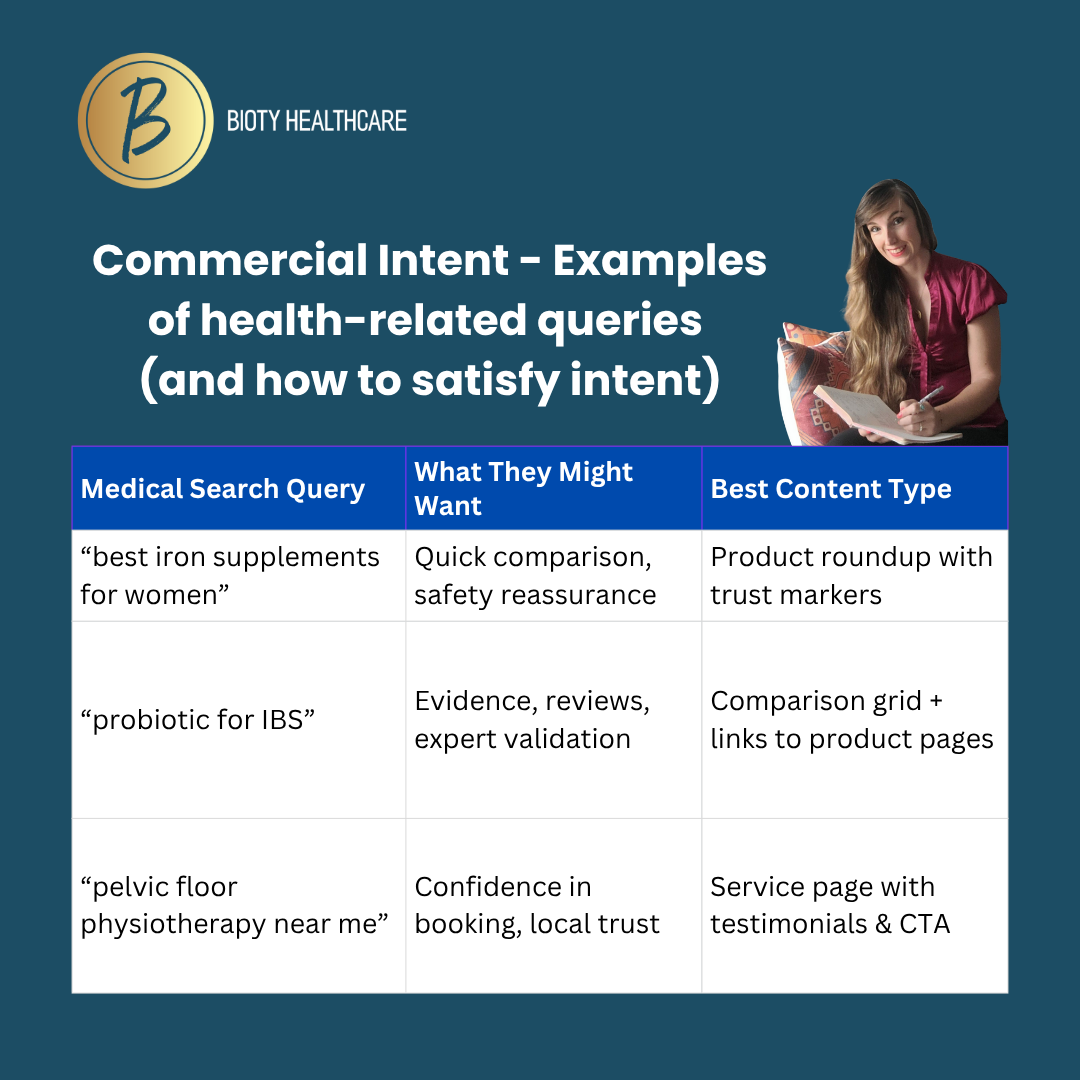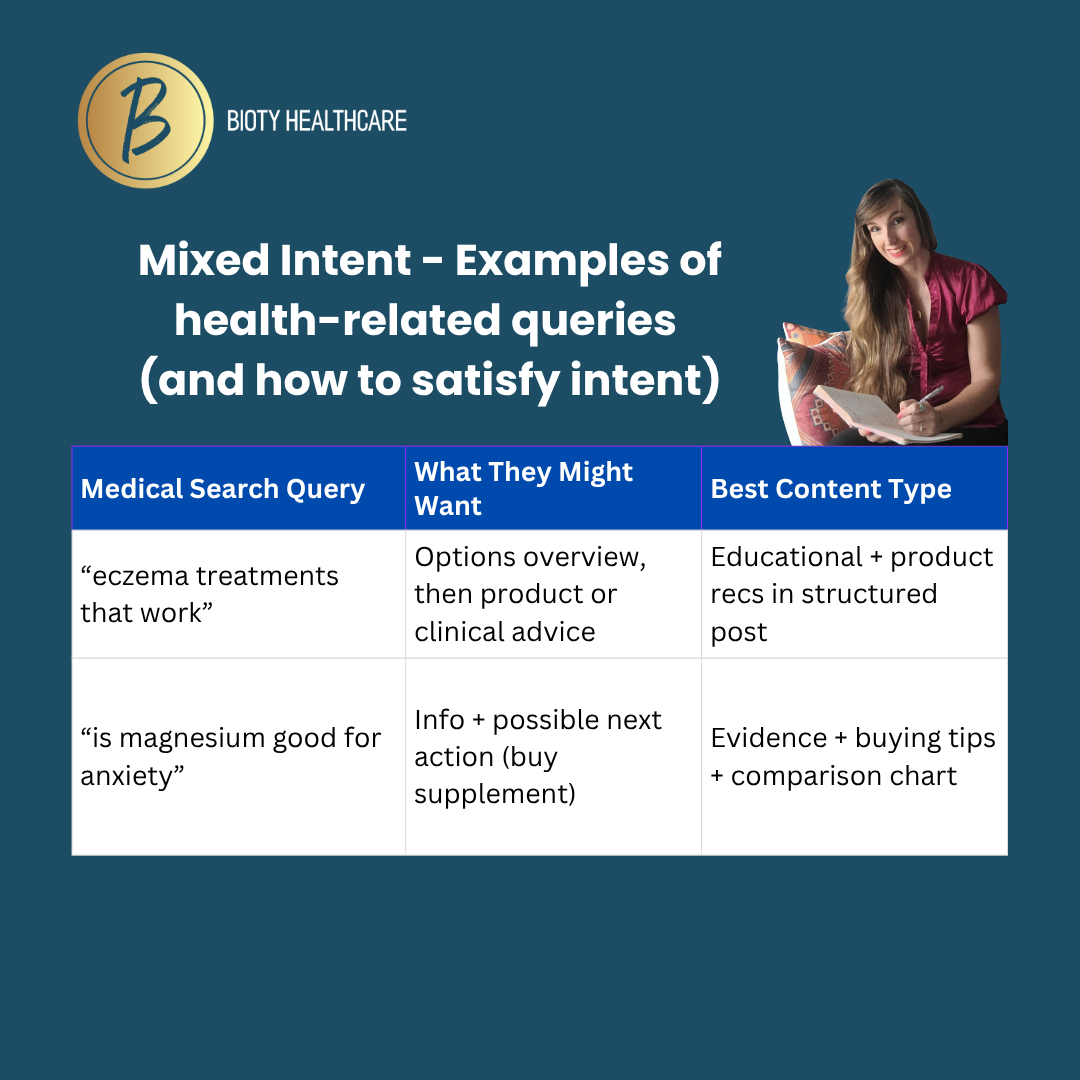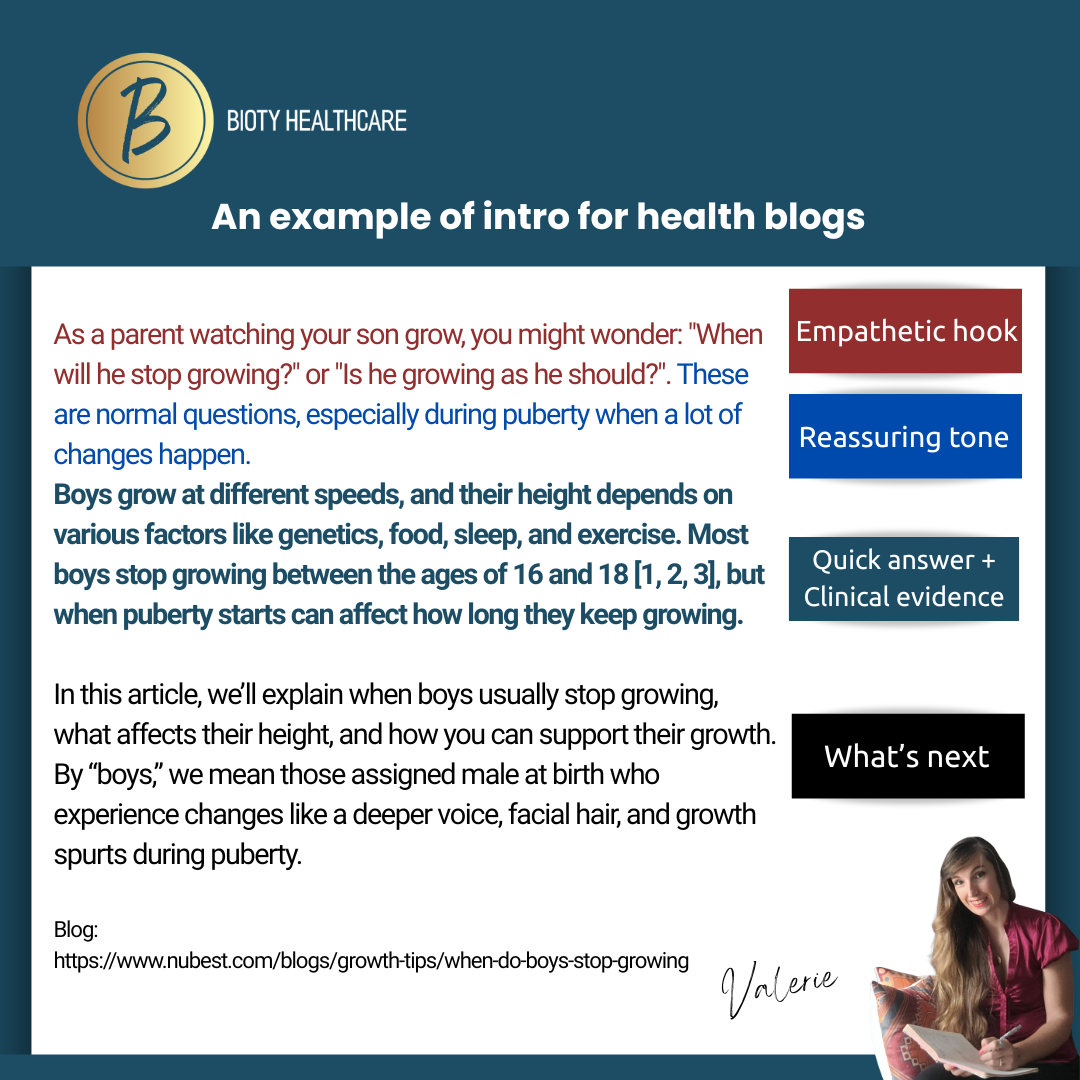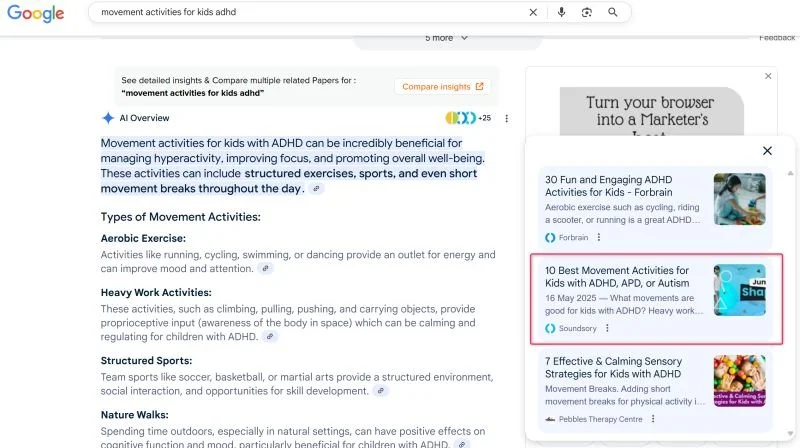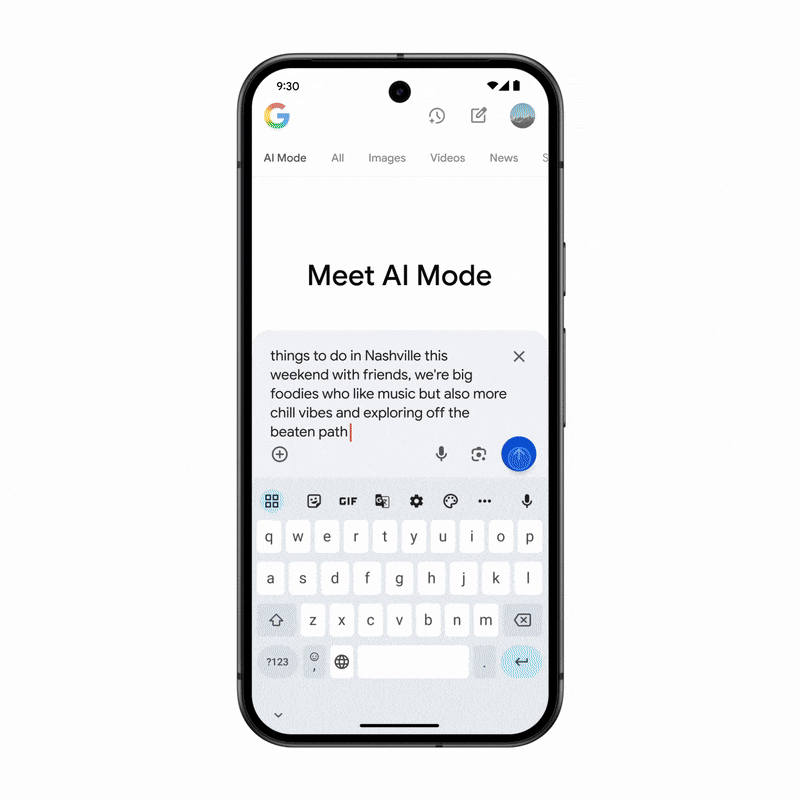What Your Reader Really Wants: Understanding Human Search Intent in Health Content
As a mentor to health and medical writers, I noticed this: what makes a great SEO health writer is in how well they understand what the reader truly wants and feels in that moment they hit ‘search’ (their search intent), besides knowing the science behind their claims.
Understanding human search intent is important in any field, but even more so in health, where fear, confusion, and curiosity can coexist in a single query when we’re writing for a lay audience.
Defining intent properly makes everything clearer for health writers: it defines your tone, structure, opening lines, and even your CTAs. One of my clients called intent the “North Star” of health writing, and I find it very true.
Understanding intent better will help you build trust, and we will see how this is becoming increasingly essential with the emergence of AI-driven searches.
In this post, I’m going to show you how you can figure out what your reader really wants, and how to deliver it with confidence, clarity, and care.
TL;DR: Understanding Human Search Intent for Health Writers
1. Human search intent = emotion behind the query
Understand what the reader feels and needs (not just what they typed).
2. Adapt tone & structure to the reader’s mindset
Use bedside-manner tone: soothing, hopeful, confident (depending on the searcher’s emotional state).
3. AI-optimized = human-optimized
If it helps your reader clearly, AI will notice too: keep focusing on search intent.
4. Write for the moment, not the keyword
Treat every query like a small emotional moment. Respond with both care and clarity (besides scientific accuracy).
What Is Human Search Intent (and Why It Matters More in Health) ?
To put it simply: search intent is about people, it’s the why behind the search: the real human emotion, goal, or question users have in mind as they search online.
It’s what made Rob open Google at 10:42 p.m. on a Tuesday and type in “magnesium side effects.” So many writers will start diving right in by explaining the science accurately (fair enough). But Rob isn’t just looking for facts and medical data. He’s probably staring at a bottle of magnesium he picked up at the chemist earlier, wondering if the cramping he’s feeling is normal or if he just made a mistake. Or worse: the bottle was full earlier but it’s now empty, where he left it on the kitchen table. He forgot to put it away. He thinks about his toddler, and the guilt is killing him.
Rob is terrified. It’s very unlikely he will listen to your scientific facts in that state. Don’t you think?
Likewise, in some cases, patients only want to hear stories from other patients who went through the same struggles. And it’s our job to find out what they need in that moment.
Research shows that searching for health info online can help people manage their health [1]. But the problem is that it can also cause anxiety when they see too much information, and this stress may lead to more doctor visits as they seek reassurance [1].
A Note From My Work With Healthcare Professionals
If you’re a healthcare professional, you may already have a good idea of the questions and concerns patients have in mind and how they feel… but do you really know everything? Embarrassing topics like mental or sexual health often get asked when people are alone and looking for answers, when they’re too ashamed to ask anyone around them (including their GP, pharmacist or therapist). So they turn to their friend Google, or ChatGPT, before consulting a doctor. That’s why healthcare professionals I’ve been working with could still get a lot of additional insights from analyzing the SERP (Search Engine Results Page). They could also get access to so many more patients, as their content gets to the top of search results (thanks to SEO).
“Our approach is to write for the user first THEN we can optimize further if (and only if) necessary. Intent is about trust and timing.”
Search Intent is the real emotion behind the search
Let me show you what I mean with a real example. I once wrote a blog for NuBest titled, “What Happens If You (or Your Child) Eat Too Many Vitamin Gummies?”
The keyword was: “eating too many vitamin gummies”. But here’s the trick: parents might Google that because their toddler just downed half a bottle of vitamins and they’re trying not to panic.
That search isn’t about nutrients. It’s about fear. It’s “do I need to go to the ER?” in disguise.
So I didn’t open the article with bland definitions. I opened with empathy and reassurance: “Maybe your child asked for an extra one, or you found an empty bottle and aren’t sure how many they ate. It’s normal to feel worried and wonder…”
That’s what I mean by human search intent. And if you’re a health writer, it’s (pretty much) everything, and it’s wildly ignored by many (not blaming you: you don’t know what you don’t know!). That’s why I’m here to the rescue!
Why Writers Need to Read Between the Lines and Beyond Keywords
Here’s a more complicated scenario: you’re facing two keywords that look almost identical but carry very different emotional weights (and therefore require different writing strategies), and you’re asked to come up with two blog outlines.
Example: “Magnesium for sleep” vs. “Best time to take magnesium for sleep”
The first query is exploratory: someone’s curious about whether magnesium even helps with sleep. This means you need to start by building trust, offering scientific context, and gently guiding them toward benefits.
The second is more commercial. They already believe magnesium works, and they just want to use it correctly. You can skip the “what and why” and focus on timing, dosage, and maybe even mention a product.
Can you tell how a slight change of keyword can lead to two very different articles?
I’ve already had to fully rewrite a draft because a client changed the main keyword after I wrote it. The new keyword had a different intent, and the original structure no longer fit. Lessons learnt:
I always align my outline with intent and get my keyword validated before I start writing.
When you’re asked to do a “ simple change of keyword”, it may mean a lot more than placing the new keyword in strategic places instead of the old one: it could mean a full rewrite!
The 4 Types of Search Intent in Health
Let’s break down the standard four types of search intent (these are very high-level, but that’s a start):
1. Informational (~80% of queries in health)
Example of informational keyword: “What are the symptoms of iron deficiency?”
Your job: Answer clearly, quickly, and in plain language. You’re not writing a research paper, you’re meeting someone looking for quick answers at home. “Informational” doesn’t always mean dry, academic or clinical. It means helpful, reassuring, and clear. You’re there to guide, not impress.
If you work with international businesses like I do, you should also be mindful of where your audience is based: a recent study found that online health information seekers who live in areas with better healthcare access are more likely to be proactive in their search for solutions [1]. But in regions with limited access, they may be looking for information that helps them self-manage [1].
Other examples of informational queries (and how to satisfy the intent):
Examples of online medical queries with an informational intent, and examples of how to satisfy the intent.
2. Navigational
Example of navigational keyword: “Bioceuticals magnesium muscle ease”
This person already knows what they want and they already know the brand, product, or website. These queries are typically targeted by landing pages.
3. Commercial
Example of commercial keyword: “Best magnesium for muscle cramps”
Now we’re talking buyer intent. Readers are comparing their options. Your blog should be a mini guide or review — show options, highlight differences, and position one as the best fit (ethically).
Examples of online medical queries with a commercial intent, and examples of how to satisfy the intent.
4. Transactional
Example of transactional keyword: “Buy magnesium glycinate Australia”
Transactional intent is when they’re ready to swipe their card. If you’re a writer for an e-commerce health brand, your job here is to smooth the path: clear product pages, no fluff, lots of trust signals (EEAT).
Examples of online medical queries with a transactional intent, and examples of how to satisfy the intent.
Val’s Tip for more experienced writers: there’s a fifth type (mixed intent)
Then you have what we call “fractured” or mixed-intent keywords — these are trickier, but a goldmine if you get it right. Those might return a mix of product pages and informational blogs on the first page of the SERP for example.
What this means for you as a writer:
Mixed-intent keywords are a chance to layer value. That might mean:
Writing a super scannable piece with clear subheadings for each user type (e.g., “What It Is,” “Benefits,” “Side Effects,” “How to Take It,” “Where to Buy”).
Using internal links strategically: guide readers to deeper or more focused content depending on their needs.
Examples of online medical queries with a mixed intent, and examples of how to satisfy the intent.
Bonus Tip (otherwise it would be too easy): Intent Can Shift Over Time!
Here’s what most SEO beginners don’t know: search intent isn’t fixed. A keyword that was once purely informational can become commercial overnight if new supplements, treatments, or controversies hit the market.
Health businesses would need to recheck SERPs regularly, especially when they’re updating older content. As a writer, you may need to pivot your structure, tone, and CTA to stay relevant. Maybe adding visuals, videos or interactive tools could be relevant for this content to stay competitive.
How Writers Should Read Between the Queries
You’ve probably heard it a hundred times: “Know your audience.” Okay, but when it comes to SEO, it’s not just about who you’re writing for, it’s about what they’re thinking in the moment they Google something. And as a freelancer, I’m often starting from scratch and with very limited information on my audience. I’m used to investigating, and analyzing intent is one way to get precious insights on the audience.
As Jenna Congdon, RN, BSN, a Freelance Health Content Writer with over a decade of critical care nursing experience, explains:
“Content writers with a nursing background excel at this skill. We accurately parse what customers are REALLY searching for when they look up that vague SEO term.”
Let’s break down how to decode intent from a keyword (so that you know if you’re writing the right blog).
A woman looking for health information online as she holds her sick child sleeping in her arms - in what emotional state do you think she is in? Source: pexels.com
Step 1: Look Beyond the Keyword
Start by asking yourself:
What does someone feel when they type this in? What do they need to hear right now?
Examples:
“Can toddlers take probiotics?” = Reassurance.
“Best probiotic for toddlers Australia” = Comparison + buying help.
Now plug that keyword into Google. The top 3-5 results are your best clues. Which leads us to...
Step 2: Use the “3 Cs of Search Intent”
When analyzing a SERP (Search Engine Results Page), look for the 3 Cs:
Content Type – Is it a blog, product page, category, video, or Q&A forum?
Content Format – Listicle? Deep guide? Case study? How-to?
Call to Action (CTA) – Are they selling, educating, or funneling toward another post?
Why it matters: If the top results are all buying guides and you’re writing a general overview, you’re not matching intent, no matter how well it’s written.
So if Google is showing product roundups? Don’t fight it. Lean in. Write a content-comparison post. Add CTAs. Use your authority to help readers choose well.
Step 3: Study People Also Ask (PAA) As Your Cheat Sheet
People Also Ask for the keyword “magnesium in pregnancy”
The “People Also Ask” (PAA) box is your secret insight machine (oops, not so secret anymore!). These questions show you:
How people phrase their fears (“Is it safe to take magnesium?”)
What specific info they want (what happens if magnesium is too high / first signs of toxicity)
And what mindset they’re in (asking for safety = concerned for their health and the baby)
Use PAA to map emotional intent, and structure your blog to answer those questions (you can use them as H2s or FAQs).
To make sure you’re not missing any step like this PAA analysis when you write or edit an SEO-friendly health blog:
Val’s Tip: Write for the Moment
One of the biggest shifts in my writing came when I stopped treating keywords as topics and started treating them as tiny windows into a moment of need.
If someone lands on your blog with a medical question, guide them, help them feel seen, and show them what to do next (e.g. do they really need to see a doctor?).
Writing With Intent: Matching Emotion, Tone & Structure
Having the right intent in mind, let’s figure out the matching tone and structure you need to follow to satisfy it better than anything already published online. This will help you improve build trust, and even help brands improve UX and conversion without the concern of being salesy (you’ll only be perceived as helpful). As Jenna notes:
Here’s how to get your health content to resonate:
Step 1: Use a Tone That Matches the Moment
In health writing, your tone has to flex with intent. Think of it like bedside manner — what would your reader want to hear right now?
Symptom searches → Soothing, calm, and grounded in facts.
Think: “Is this serious? Should I worry? Just tell me what to do.”Wellness trends → Energetic, hopeful, curiosity-sparking.
Perfect for things like adaptogens, biohacking, or “gut health” guides.Product pages or commercial content → Clear, confident, and helpful.
The reader’s already interested — make their decision easier.As Jenna notes:
“Patients need both details and empathy, but knowing when to lead with one or the other is key to earning their trust.”
Step 2: Choose a Structure and Outline That Supports Intent
Structure is about better readability and giving readers what they expect (and need) based on where they are in their journey.
Informational → Listicles or FAQs
These readers want clarity fast. Use numbered lists, short intros, and bolded key takeaways.
Commercial → Comparison posts with CTAs
Add side-by-side features, pros and cons, and product links, while staying helpful (because that’s providing a solution users are looking for).
For branded or product-specific searches, make it scannable with clear sections, testimonials, and CTAs like links to shop, subscribe, or learn more.
Understanding How to Shift Your Reader’s Inner Journey in Health (Based on Their Human Search Intent)
One of the most powerful things to understand as a health or medical writer? Readers don’t always stay in one state of mind. Your blog can be part of a mental shift that happens as they read.
Here’s the typical journey:
Anxious → “Is this dangerous? Should I worry?”
Curious → “What’s causing this? What are my options?”
Empowered → “Okay, I understand it now.”
Ready to act → “I’m going to try something — what do I do next?”
Your job is to walk them through that shift — with a mix of clarity, empathy, and subtle calls to action. Do that well, together with the right amount of EEAT, and you build trust.
Something I think is important to bear in mind is that for those topics or keywords that need reassurance, writing to bring this reassurance is NOT optional if you want to build trust. This is what nursing research shows: reassurance begins when emotional distress is detected, and works through three pillars: emotional presence, empathetic tone, and crystal‑clear communication [2].
In health writing, this translates to opening with calm empathy, acknowledging the fear, and using direct, comforting language to build trust, even before you start sharing facts or advice.
An example of a health blog introduction using an empathetic hook and reassuring tone before bringing the answer to the human search intent behind my keyword “when do boys stop growing”.
Let’s break down how the vitamin gummies blog does this (brilliantly, I know!):
1. Anxious → A parent finds this blog at 10:47 p.m. after their toddler raided the vitamin cabinet. They’re panicking, heart racing, wondering if they need to rush to the ER.
“Most of the time, eating a few extra gummies won’t cause harm…”
You open with reassurance. You name the fear, then soften it with calm, fact-based context. That tone matters — it earns trust immediately.
2. Curious → Once the panic eases, they want to understand. Why is this dangerous? Which vitamins are the real concern? What symptoms should I look for?
You break down fat-soluble vs. water-soluble vitamins. You explain the difference between mild and severe symptoms. You introduce real-life overdose scenarios, which validate their concern and show what responsible action looks like.
This is where you shift from answering a fear to satisfying curiosity.
3. Empowered → Now the reader feels informed. They understand the risk. They’ve read about warning signs and expert advice.
Here’s where you step in, offering preventative tips, safer supplement choices, and guidance on how to teach kids the difference between vitamins and candy.
“Store gummies out of reach… explain they’re not candy… choose sugar-free, properly dosed options like NuBest Tall Gummies.”
You’re giving them a toolkit. And they feel in control again.
4. Ready to act → By the end, the parent is motivated to choose better products, set new routines, and maybe even bookmark the post or send it to their partner.
You close with clear actions, resources, and reassurance.
For a better idea of what this looks like in real life, here’s a practical breakdown that aligns the patient journey with emotional states, recommended writing tone, structure, and even the type of search intent behind each query. Use it as your go-to guide whenever you’re mapping out a health blog.
Patient journey content strategy guide : Aligning tone, voice, and search intent across care stages
| Patient Journey Step | Prevention-Focused? | Emotional States | Recommended Tone | Suggested Voice | Matching Structure | Matching Search Intent |
|---|---|---|---|---|---|---|
| 1. Awareness | ✅ Yes | Curious, open-minded, slightly anxious, hopeful | Warm, approachable, optimistic | Friendly expert — like a wellness-savvy friend who knows their stuff | Brief intro + quick facts / myth-busting list | Informational |
| 2. Symptom Recognition | ❌ No | Worried, self-doubting, ashamed, fearful | Reassuring, calm, non-judgmental | Gentle guide — like a nurse explaining things in a kind, no-rush way | Reassuring FAQ + symptom checklist | Informational |
| 3. Seeking Diagnosis | ❌ Rarely | Anxious, vulnerable, frustrated, overwhelmed | Grounded, empathetic, clear | Trusted educator — factual but soft-spoken, like a GP who listens | In-depth explainer with expert quotes | Informational / Mixed |
| 4. Exploring Treatment Options | ✅ Sometimes | Motivated, hopeful, cautious, sometimes skeptical | Balanced, evidence-based, empowering | Balanced consultant — fair, transparent, never pushy | Comparison guide or product round-up | Commercial / Mixed |
| 5. Ongoing Management | ✅ Yes | Empowered, relieved, committed, sometimes tired or discouraged | Supportive, encouraging, honest | Long-term partner — like a coach or care team member who checks in | Step-by-step plan or long-form evergreen post | Navigational / Transactional |
Why Intent Future-Proofs Your Content for GEO (Generative Engine Optimization) and AEO (Answer Engine Optimization)
For the newbies, here’s what GEO and AEO mean in practice:
GEO (Generative Engine Optimization) is about optimizing your content so that large language models (like ChatGPT, Gemini, Claude or Perplexity) can understand, reference, and use it when answering user queries.
AEO (Answer Engine Optimization) focuses on making your content appear as a quick answer in search: think Google’s featured snippets, AI Overviews, or voice search responses.
In other words:
SEO = so that your content appears at the top of search results
GEO = so that your content gets pulled into AI and appears in answers from LLMs
AEO = so that your content lands as sources in the quick answer box
And here’s the secret truth (let’s keep this between us): if you’re writing clearly, structuring with intent, and genuinely helping people… you’re already doing a huge part of it.
What AEO Looks Like in Practice: A Real-World Example
Let me show you what this looks like in the wild — because yes, focusing on intent (and EEAT) works.
Here’s a recent example from my Friday SEO tip series on LinkedIn: I acted as the SEO editor on a blog for a client, about movement activities for kids with ADHD. At the time of writing, there was no AI Overview available for the keyword, but a few weeks after publication, it’s now featured above Healthline in Google’s AI Overview.
Example of an AI Overview for the keyword “movement activities for kids ADHD”
Why did it land there? This blog was written with intent alignment in mind, every step of the way:
The blog is opened with an emotionally resonant, trust-building line:
“With years of experience working with kids, I know how important it is to choose activities that are both fun and helpful.”The content is structured to reflect what the reader needed:
short intro → types of movement activities → clear subheadings → bulleted examples (like aerobic exercise, heavy work, nature walks…).And we used a strong FAQ section with conversational formatting — likely what got picked up by the AI.
One month later (May 2025), the article ranks #5 in the SERPs and appears in the AI Overview — above some of the most trusted names in health content like Heathline.
That’s the power of writing for humans first!
I’ve asked Konrad Szymaniak, Enterprise SEO Consultant at Szymaniak Digital in the UK, how he approaches search intent for medical brands, and his insights echo what I often teach my mentees.
With one of his clients, The Medic Life, his team begins by mapping each audience segment (like students prepping for UCAT exams or medical interviews) to their specific search behaviors. Then, they match that against the SERP: does the keyword call for expert guidance, peer-led advice, or an academic explainer?
One great example he shared: a query like “best UCAT preparation strategy” used to return traditional blogs. But with the rise of AI Overviews, summary-style content is now favored.
“With The Medic Life, we’ve shifted our approach from “just long-form” to “AI-digestible + human-useful.” That means:
1. Creating semantically rich, clearly chunked content with strong internal linking
2. Adding summary boxes, expert highlights, and checklists that AI can lift
3. Testing how content appears in AI Overviews (via tools or manual prompts)
4. Ensuring tone remains empathetic, especially important in health education where trust is vital
Ultimately, we’re optimizing for AI without losing the human.”
👉 To know more about AI Overviews, I’ve written a complete guide on how to get featured in AI overviews for health businesses based on my learnings.
Why Human Search Intent Still Rules (Even in Google’s AI Mode)
Generative search doesn’t kill search intent: it supercharges it.
Google’s AI Mode, launched in March 2025 in the U.S., is another clear sign that search is evolving fast: it’s more conversational, contextual, and answer-first. AI models don’t just want keywords. They want clarity, empathy, and structure.
That’s why search intent matters more than ever.
Google’s AI mode. Source: https://www.seroundtable.com/google-ai-mode-io-39444.html
In health and medical content, trust is the real finish line (rather than ranking). And AI systems pull from high-authority, intent-aligned content that meets readers exactly where they are.
They reward brands and writers who can read into users’ minds and:
Understand nuance and emotional drivers
Prioritize accuracy and clarity
Write like empathetic educators
In short:
✔ Structured, digestible, deeply relevant content gets pulled into AI Overviews
✔ Writers who match emotional + informational intent lead the pack
Final Thoughts: How to Be the Writer Who “Gets” the Reader
Here’s the short version:
👉 Understanding human search intent is at the core of content that actually works, especially in health. It helps you speak to the real question behind the query, not just the keyword.
👉 Intent isn’t fixed. The same keyword can reflect a different mindset over time. Re-check the SERPs regularly: content that ranked six months ago might miss the mark today.
👉 GEO and AEO are not new playbooks: they’re upgrades to what good SEO writers already do. If you’re already writing with clarity, empathy, structure, and evidence, you’re increasing your chances of landing in AI Overviews or getting referenced by an LLM. You should be even more mindful of formatting your insights so clearly that AI can quote you, summarize you, and trust you. And for AI to trust you as an expert, this goes with being visible as an expert, appearing on multiple channels online (LinkedIn, Youtube, blogs, health publications…).
Are you curious about learning the ropes of being an SEO health (or medical) writer?
Join my mailing list for free resources, SEO tips, and updates on upcoming courses. Whether you're starting fresh or shifting careers, there's room for you in this space. You only need to drop your details in the form below. 👇🏼
Val ✍🏼
FAQ: Understanding Human Search Intent as a Health & Medical Writer
-
It means knowing the emotional and informational need behind a search query — not just what the reader types, but what they feel and want to know in that moment.
-
The four types of search intent are: informational (seeking knowledge), navigational (finding a specific brand/site), commercial (comparing options), and transactional (ready to buy). Health blogs need to match the tone and structure to each intent, and most importantly, the headspace the searchers are in.
-
Start with the keyword, then look at the top-ranking content. Ask yourself: What format is ranking? What mindset is the reader in? Use this to guide your structure and tone (besides what you already know from your experience and your clients, of course).
-
The 3 Cs of search intent are Content Type, Content Format, and Call to Action. Analyze the SERP for these patterns and mirror them in your health blog to match what searchers expect and need.
References
Di Novi C, Kovacic M, Orso CE. Online health information seeking behavior, healthcare access, and health status during exceptional times. J Econ Behav Organ. 2024;220:675-690. doi:10.1016/j.jebo.2024.02.032
Akyirem S, Salifu Y, Bayuo J, Duodu PA, Bossman IF, Abboah-Offei M. An integrative review of the use of the concept of reassurance in clinical practice. Nurs Open. 2022;9(3):1515-1535. doi:10.1002/nop2.1102
About the Author
Valérie Leroux, MSc, is a bilingual SEO health writer and founder of Bioty Healthcare since 2022, helping health brands and medical writers create high-ranking, trustworthy content backed by science and empathy.



